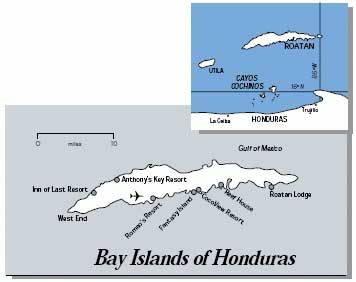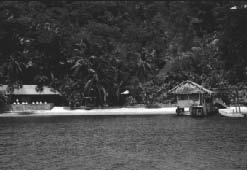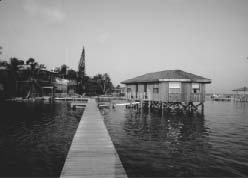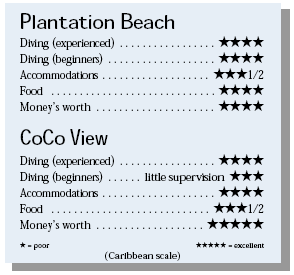Two Weeks In HondurasContents of this Issue: Are You Paying for Marine Life Harassment? DCS & the Recovery of TWA Flight 800 Editorial Office: Ben Davison Publisher and Editor Undercurrent 3020 Bridgeway, Suite 102 Sausalito, CA 94965 From CoCo View to Plantation Beach from the September, 1998 issue of Undercurrent
For seven days in May I fantasized and planned my upcoming venture to Indonesia. As I prepared to call my travel agent, my editor called me. "My friend," he said, "the Asian bust has hit your Indonesian airline. It's lost its lease on planes, has erratic schedules if it flies at all, and you may find yourself spending two weeks in Jakarta with nowhere to go." After a day of deep depression, I decided to forego the big-fish action for easy diving. I'd save a few bucks and tag along with my local dive club to Honduras. And, while two weeks at any Bay Islands venue would get boring, with a week at the isolated Cayos Cochinos and a second week on Roatán, I'd get enough variety to make each day a new adventure. Of course, I didn't think that getting to Honduras would be as tough as making a trip to Indonesia--not until I made reservations on a new carrier, Honduras Air, and watched it go belly up a few days later. I ended up flying Continental to San Pedro Sula, a flight that arrived three hours late and left behind twelve divers' bags, including mine. Then there was the three-hour bus trip to the city of La Ceiba, where, along with Dick, our dive-club guide, we were to board the Wahoo II, Plantation Beach's comfortable and speedy Pro 42 dive boat, for the ninety-minute ride to the resort. Unfortunately, by the time we reached La Ceiba, the evening winds had already kicked up, which kept the Wahoo in port. So instead of having a rum punch and gentle waves lull me to sleep on Cayos Cochinos, my lullaby emanated from the town square alongside the Grand Hotel Paris. At this point, even Jakarta didn't sound so bad. But by morning, after breakfast, a helping hand with my
bags, and an uneventful Pro 42 trip to the resort, things
started looking up. Just arriving at Cayos Cochinos, a cluster of islands 25 miles northeast of La Ceiba, was
a step in the right direction. The resort, owned by an old-salt New Englander, Dave Burchard, features an attractive, wood-hewn main building with a verandah for sunsetviewing, a bar and dining area, and several guest rooms. While the rooms have been improved since my last visit-- internal walls and sleeping lofts have been added--you'll still know whether your neighbors are lovers. Hillside rooms have the best views and breezes, and #5, a single unit, is worth reserving ahead of time. The folks at Plantation Beach worked hard to keep me happy. The dozen of us who arrived late, sans gear, were all supplied with resort gear in time for the morning dive. (Tip: at a minimum, carry your mask, computer, and wetsuit with you on the plane; most resorts can provide other gear.) Of all Honduran diving, I like this best: sizable grouper and hogfish swim the reef, and there's fine macro. Although sharks and pelagics are rare, the diving's good enough to attract both the Bay Islands Aggressor and Peter Hughes Wind Dancer regularly. Even Anthony's Key Resort sends a day boat on the 20+ mile crossing from Roatán. Yet had this been my first trip--it was my fourth--I would wonder why they made the trip. You see, in early July the wind limited access to better dive sites and stirred up the bottom on others. The 40-50 foot visibility at Pelican Point I and II dulled the view of a beautiful reef structure and obscured the fish. On my last visit I watched eagle rays cruise the wall, but if they were there this trip, I couldn't see them. Fortunately, Charlotte's Choice was brighter, with a veritable forest of large purple and tan sea plumes and sea whips. On a divemaster-led dive at 40 feet, I watched slender filefish hiding in their branches. The Gardens had some bizarre critters, including the unusual and exquisite row encrusting tunicates, which resemble a brocade vest. Here I stared back at five secretary blennies in a coral head and almost chin-chucked a quillfin blenny. A leopard flatworm swam at me as I tried to photograph it, and sailfin blennies battled each other. Along the reef, a school of blue parrotfish grazed, and cowfish, scrawled filefish, and queen triggers eyed me warily. In a school of Creole wrasse, each male shepherded a female, extending his white lips and nudging the female almost constantly as they swam along. This was an excellent Caribbean dive, with plenty of fish and reef cover. Beach diving is minimal. A few macrophotographers dived off the beach on the small reef structure to snap orange ball corallimorphs, baby spotted drum, or silversides under the pier.
Because there is little to do on the island other than chat with your chums, read a book, paddle a kayak, or nap, meals became an event. The generous, three table dinner buffets served up entrees such as tasty grilled snapper, delicious seafood kabobs, or excellent chicken and pork chops, all accompanied by peas, rice, and a few veggies. Beer was $2.50; wine, $4; sodas, $1; and mixed drinks, $3. Desserts (such as key lime pie or crunchy cookies) satisfied most everyone. While some breakfasts featured eggs, pancakes, French toast and fresh pineapple or papaya, I didn't care for the cold cereal with warm milk we were served on some mornings. Since the two Americans who operate the dive operation, Don and Roger, had lent us wayward divers their equipment, we were on our own to figure out the dives after a good verbal briefing. Finding our way was easy enough, and we managed to stretch our dives to an average of seventy-five minutes in the warm, 82° water. When Don or Roger joined us on later dives, they enthusiastically pointed out macro subjects hidden in the cracks and crevices of the reef. On one dive Don produced a pygmy flounder a few inches long that he believes is an unidentified species. Once back on the boat they were knowledgeable enough about sea creatures to answer most of our "What the hell was that?" questions. Both have been here for several years and know the area well, and Tataya, the deck hand, always helped out. A two-tank morning dive (using aluminum 80s) and one afternoon dive (replaced by a night dive one day each week) is the rule. Of course, this might not be enough for some divers, and there were other problems as well. Although their Pro 42 is fast, even a boat this size has trouble handling twenty-one divers, and the single camera rinse tank was inadequate for the cameras on board. Still, the resort's helpful attitude counted for a lot. To travel to CoCo View, for example, I had prearranged with the resort to have a local boatman and his cayuko take my buddy and me the 22 miles ($80). However, Roberto and his cayuko were no shows; thankfully, Dave had Tataya run us over in a skiff. And, as for that missing dive gear, while Continental had promised it in twenty-four hours, it took three days to show up. Next Stop CoCo View on the Island of Roatán In the early 1980s, CoCo View was as homey as Plantation Beach is today. However, booming success--it's got to have the highest occupancy rate in Central America-- turned it into the 66-guest dive resort it is today. So why is it so popular? Well, for a diver who insists on five dives a day but wants his bed resting solidly on terra firma, few resorts can match CoCo View. While they offer only two boat trips daily, on the way back from each they'll give you a fresh tank and drop you off for one of the best resort-front dives anywhere in the Caribbean: a 110-foot wall, the wreck of the Prince Albert, a sunken plane, and lots of coral heads in the shallows. For some people, even this isn't enough. While CoCo View hasn't lost all the homey touches it had when I was here fifteen years ago, it's become more of a well-oiled machine for pumping divers through, which means that it appeals more to hard-core divers than more relaxed ones who are drawn to relaxing on the beach. I watched two father-teenage-son teams hustle to make their goal of thirty dives in six days while using their surface intervals for games of pool, pingpong, sea kayaking, and God only knows what else. Me? I logged nineteen, because there was just too much kickin' back to do. But before you jump up and say that five-dive days make CoCo View equivalent to a live-aboard, keep one thing in mind: you'll cover the same well-dived area on most dives, and, while the terrain is beautiful, fish life can be limited. Still, given the limitations of land-based diving, the resort does its best to make the most of its setting. It's a beautiful site, although no-see-ums can be ferocious here. To avoid them, I stayed over the water in a spacious bungalow on stilts with two double beds, large bath, and a back porch with a hammock and table and chairs. Often I'd see a small spotted eagle ray, a large porcupinefish, or a barracuda or two cruising the shallow water below us. Unfortunately, the roar of jet skis from Fantasy Island, a resort across the way, disrupted the tranquillity at times. CoCo View's two-story main building houses a game room, a small bar overlooking the entry way for shore diving, and two floors of tables and chairs for dining. A man-made island with a hammock-laced gazebo and an adjoining sundeck adds to the atmosphere. Meals, served buffet-style at fixed times, were plentiful, the quality you might expect in a family-style resort--in other words, the clam chowder might be Roatán's best, but surely not New England's best. At lunch, they offered a choice of a meager sandwich and something hot; dinner, a choice of a seafood or another entree with a paltry salad bar. Their desserts were a hit with many, but not with me. Cooked-to-order breakfast included eggs, pancakes, waffles, French toast, cold cereal, and fruit. However, on my last day I had to depart before breakfast; that meant no food, nada, not even coffee. Now a real family place ought to give a little thought to that. And the staff might get a little more visitor-friendly. Some were "just doing their job," but others were trying to be helpful, even if sometimes they didn't convey the feeling of enjoying what they were doing. In some cases the resort just hadn't thought the details through: upon arrival, for example, they deposit luggage at a stand "near" your room, which can be several hundred feet away. (How about sending the guys with the carts to the doorstep?)
However, the activities director, Lauray, is nothing but helpful. She suggested a trip to the Iguana Hideout and the Tropical Treasures Bird Park in the West End and arranged the jeep rental we'd need to get there. This area has a different atmosphere than elsewhere, catering to European and Australian backpackers who stay awhile and perhaps get in a couple of dives. There's an Online Cafe where you can send e-mail, and, near French Harbor, the picturesque Tres Flores restaurant has a 360-degree view from its porch. Owned and run by an American couple, it's a great site for sunset dinners, offering excellent margaritas to accompany their TexMex cuisine.
About the only rules in diving were not to go below 130 feet without approval and to get back on the boat after 60-65 minutes. Otherwise, you could go off with your buddy and dive your computer but were asked to bring back 500 psi in your 80 cu. ft. tank. CoCo View assigns you to one of four locally- hewn boats and a divemaster for the duration of your stay, so you get to know the folks and don't unnecessarily repeat dives. The boats were comfortable and held up to 20 divers; two had interior ladder entry, making it easy to climb aboard in rough seas, of which we had plenty. If you asked, a camera rinse tank was provided, though it wasn't quite big enough for my camera. Back at the resort, I rinsed and stored my gear in CoCo View's locker area, using the hooks and cubby-holes. I never gave much thought to the lack of individually-locked storage units until one diver missed his regulator and air-integrated computer. (It was not recovered.) So much for the family atmosphere. My assigned guide gave a short briefing before we left the dock--we were told where to look for frogfish and sea horses and, sure enough, there they were--and pointed out critters. Most Roatán diving is very similar, with few significant differences from resort to resort. Expect a nice variety of hard and soft corals and not much in the way of big stuff, though I did see a couple of nurse sharks and a turtle. At Calvin's Crack, where a wall is covered with tube sponges and gorgonians, I dived past schools of Creole wrasse swimming with their boga companions in the 83° water, then passed through a fissure, lined with gorgonians, whip corals, and azure sponges, where fairy basslets darted about. At 85 feet, several mackerels cruised the wall, and at Forty Foot Point I followed a briefing tip and discovered two sea horses, a yellow one and an orange one. The azure sponge and gorgonian-laced wall sported an abundance of fish, including bar jacks, white spotted filefish, mahogany snappers, and a couple of hogfish. When returning from the day's first dive, I'd get dropped off on Newman wall; in the afternoon, I'd get dropped off at CoCo View wall. Both are steep and covered with sponges, corals, and gorgonians, with the ubiquitous schools of Creole wrasse, snappers, and grunts. CoCo View wall had a large variety of trumpetfish that ranged from red to bright blue and green. As I entered the channel around the corner of the wall, schools of grunts huddled under overhangs, and I spotted two stingrays in the sands. In shallower water, I'd try to sneak up on yellowhead jawfish. A four-foot barracuda showed me his teeth, but backed off when I approached. Usually I had good visibility, but as the winds picked up, visibility decreased, going from 100+ feet on calm days to 40-60 feet on turbulent ones, with most days averaging 60-80 foot visibility along the wall and less in the channel near the resort. While CoCo View has some super walls and is a good choice for an inexpensive, gung-ho, land-based dive trip, for me the diving isn't spectacular or varied enough to get me in the water all that much. Rather than push my dive count up, I added more land-based activities, a good compromise for groups or couples who might not share the same passion for water time. No matter what pace you like to dive, anyone who comes to Honduras must be flexible. In keeping with the spirit of my trip, the airline on which I was scheduled to fly from Roatán to San Pedro Sula went belly up at the last minute. Thankfully, the staff at CoCo View scrambled to get me on an Islena flight. -- WD
|

I want to get all the stories! Tell me how I can become an Undercurrent Online Member and get online access to all the articles of Undercurrent as well as thousands of first hand reports on dive operations world-wide
| Home | Online Members Area | My Account |
Login
|
Join
|
| Travel Index |
Dive Resort & Liveaboard Reviews
|
Featured Reports
|
Recent
Issues
|
Back Issues
|
|
Dive Gear
Index
|
Health/Safety Index
|
Environment & Misc.
Index
|
Seasonal Planner
|
Blogs
|
Free Articles
|
Book Picks
|
News
|
|
Special Offers
|
RSS
|
FAQ
|
About Us
|
Contact Us
|
Links
|
3020 Bridgeway, Ste 102, Sausalito, Ca 94965
All rights reserved.

 With no roads, TV, or
radio and a population of forty, these small forested
islands, designated as a bioreserve by the Honduran
government and lush with orchids and bromeliads, are
indeed a paradise. Nestled in
a verdant valley facing a bay
to the west, the ten-room
Plantation Beach Resort is
barely an intrusion.
With no roads, TV, or
radio and a population of forty, these small forested
islands, designated as a bioreserve by the Honduran
government and lush with orchids and bromeliads, are
indeed a paradise. Nestled in
a verdant valley facing a bay
to the west, the ten-room
Plantation Beach Resort is
barely an intrusion.

 Of course, while the side trips were
enjoyable, I came for the diving, and
CoCo View had its dive program wellorganized.
The boats went out at 9 and
2, and alarm bells told you when to get
ready for the short trips to the sites.
An all-day trip with lunch in a small
village is offered once each week,
though during my visit the weekly night
dive (an additional $20) was canceled--
yup, the weather.
Of course, while the side trips were
enjoyable, I came for the diving, and
CoCo View had its dive program wellorganized.
The boats went out at 9 and
2, and alarm bells told you when to get
ready for the short trips to the sites.
An all-day trip with lunch in a small
village is offered once each week,
though during my visit the weekly night
dive (an additional $20) was canceled--
yup, the weather.  Diver's Compass: Plantation Beach: Price is $895 per week plus
$80 transfer to/from La Ceiba booked through Island Dreams
Travel 800-346--6116...no Nitrox available...they checked Ccards
and log books...generators ran 24 hours and rooms had
flash heaters providing hot water...CoCo View: Rooms with all
meals, diving are $800/week hi-season, $750, low; $50 more for
over-water bungalows. Beach houses that hold six rent from
$205-$505/person, depending upon the number of people; meal and
diving package is $460 for 7 nights....phone 800-282-8932, or,
for more info, see
Diver's Compass: Plantation Beach: Price is $895 per week plus
$80 transfer to/from La Ceiba booked through Island Dreams
Travel 800-346--6116...no Nitrox available...they checked Ccards
and log books...generators ran 24 hours and rooms had
flash heaters providing hot water...CoCo View: Rooms with all
meals, diving are $800/week hi-season, $750, low; $50 more for
over-water bungalows. Beach houses that hold six rent from
$205-$505/person, depending upon the number of people; meal and
diving package is $460 for 7 nights....phone 800-282-8932, or,
for more info, see 